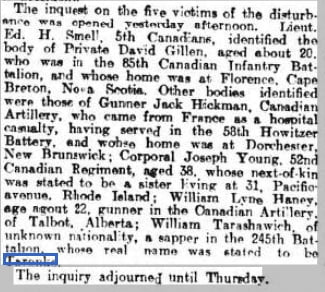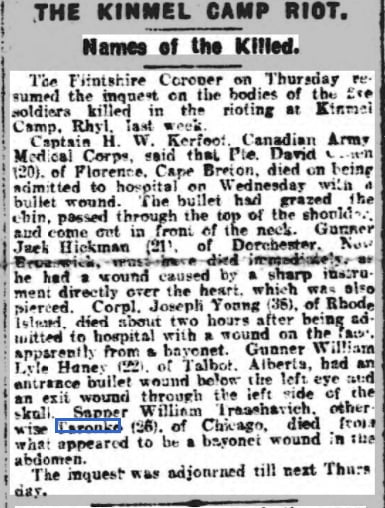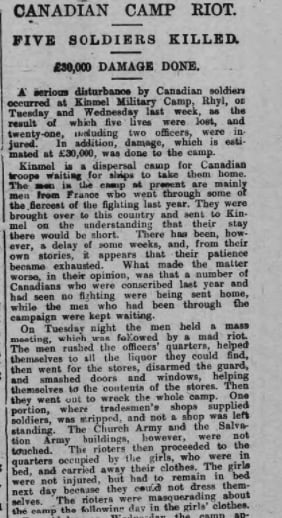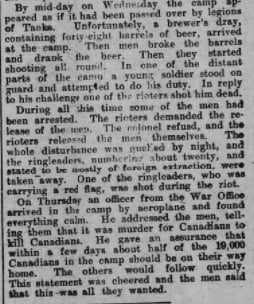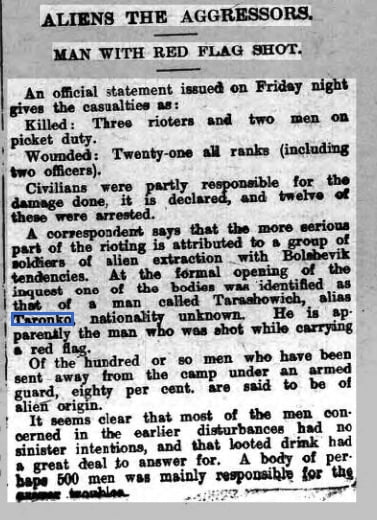William Tarasevich alias Taranko, was born on 22nd February 1889 in Grodensky gooberni Kobainskago nyder, Russia.
I cannot trace William Tarasevich on any Canadian or United States census forms, nor can I find any details of emigration to either country.
William’s Army records tell us that he enlisted into the 245th Battalion, Canadian Over-Seas Expeditionery Force on 3rd January 1917 at Montreal, Quebec, Canada. His address on enlistment was 272, Cadieux St. Montreal. His date of birth was 22nd February 1889. he had been born in Russia. His named next of kin was his Mother, Mary Tarasevich of Motolskoy, Poloste, Russia. William gave his trade as Labourer. He was single. He was described on his medical form as being 5ft 9ins tall with a sallow complexion, light blue eyes and brown hair.
After basic training in Canada, William embarked from Halifax, Canada on 3rd May 1917 aboard the S.S. Justicia arriving in Liverpool on 14th May 1917, when he was posted to Shoreham Army Camp to complete training.
On 28th March 1918 he was transferred to the 4th Battalion, Canadian Railway Troops at Bramshott Army Camp and posted to Purfleet on 12th April 1918, embarking on that day from Folkstone to Bologne and joining the 4th Battalion Canadian Railway Troops in the Field on 17th April 1918.
William lost 3 days full pay for being absent without leave from 2/10/1918 to 8/10/1918. There were a number of visits to Casualty Clearing Stations for medical treatment between 3rd November 1918 and 15th November 1918 when he had injuries and abrasions to his right hand and face.
William remained in the Field until 24th January 1919 when he was posted to Whitley Camp and then to Kinmel Army Camp to await repatriation to Canada.
(From Library of Canada Archives)
William was fatally wounded by a single bayonet strike to the abdomen and was dead on arrival at Number 9 Canadian General Hospital, Kinmel Park.
Kinmel Park Camp was a segregation camp used to house Canadian Soldiers awaiting repatriation to Canada after the end of WW1. Unfortunately the conditions at that time were extremely harsh with a lack of every kind of commodity, the camp was overcrowded and the services were poor, there were shortages of clothing, food and blankets. The Canadian troops grew dissatisfied with conditions and were desperate to get back to their homeland but unfortunately the authorities decided to repatriate the troops who had been drafted into the army in 1918 first. It could be argued that these were the men who having left jobs to join up and would therefore be able to gain employment quicker thus helping the infra structure of Canada to quickly recover. The outcome of this decision culminated in The Kinmel Camp Riots on 4th-5th March 1919 when feelings of anger and resentment in the men who had enlisted voluntarily and risked their lives in a theatre of war boiled over into violence and looting.
There are many versions of actions taken during 4th and 5th April 1919 but tragically the outcome was that five men lost their lives and William Tarasevich was one of them. He was allegedly a member of the rioters and reports state that he was carrying a red flag but this is purely conjecture and having revued all of the newspaper articles I cannot find proof of this being true. It would appear that the fact that he was of Russian extraction and that there was an anti Bolshevik movement at that time, together with a vast amount of exaggeration of the facts, fuelled the rumour that he lead the riots carrying a red flag.
He is buried in St. Margaret’s Cemetery, Bodelwyddan.
William is commemorated on the Canadian Virtual War Memorial.
Additional Information.
To read about the Canadian Railway Troops, please follow the link.
http://vimyridgehistory.com/wp-content/uploads/Canadian-Railway-Troops.pdf
If you wish to read about the Kinmel Park Riots, there is a book by Julian Putkowski , ISBN 0-9512776-1-8 available from St. Margaret’s Church, Bodelwyddan, entitled “Kinmel Park Camp Riots 1919” or follow the link.
http://www.canadiangreatwarproject.com/writing/kinmelPark.asp



